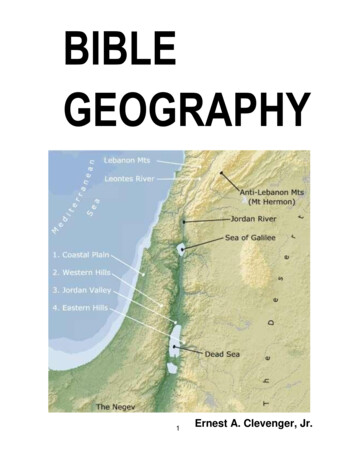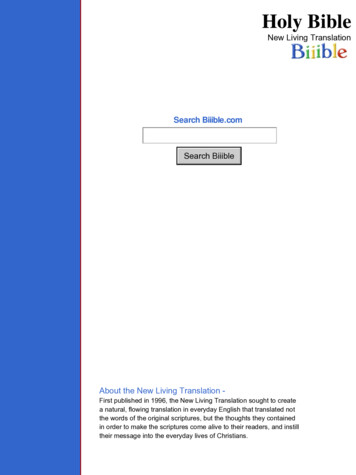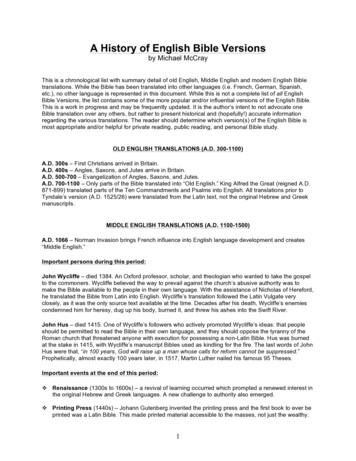
Transcription
Continue
Sinai bible english translation pdf download gratis pdf downloadWant more? Advanced embedding details, examples, and help! Customer Reviews, including Product Star Ratings help customers to learn more about the product and decide whether it is the right product for them. To calculate the overall star rating and percentage breakdown by star, we donâ t use a simple average. Instead, our system considersthings like how recent a review is and if the reviewer bought the item on Amazon. It also analyzed reviews to verify trustworthiness. Learn more how customers reviews work on Amazon The Septuagint (from the Latin septuaginta, “seventy”) is a translation of the Hebrew Bible and some related texts into Koine Greek. The title (Greek: Ἡ μετάφρασιςτῶν Ἑβδομήκοντα, lit. “The Translation of the Seventy”) and its Roman numeral acronym LXX refer to the legendary seventy Jewish elders who solely translated the Five Books of Moses into Koine Greek at the time of Ptolemy Philadelphus, (285–247 BCE) for the library in Alexandria, Egypt and the Jewish Community of Alexandria in general, most ofwhom did not speak Hebrew. The story of the elders being invited to Egypt and writing the translation is mentioned in The Letter of Aristeas, Josephus (Ant. Jud., XII, ii), Philo (De vita Moysis, II, vi), and the Babylonian Talmud (Megillah 9a-9b). Today, there are three main manuscripts of the Septuagint, in existence: Codex Alexandrinus, CodexSinaiticus and Codex Vaticanus. The manuscripts include all of the Tanach and some additional apocryphal books that used to be in the Hebrew Bible, but were removed from it during the Talmudic period. All three manuscripts are available online now. 1) Codex Sinaiticus (dispersed between 4 libraries) Description of Codex Sinaiticus from theBritish Library Website: What is the Codex Sinaiticus? The literal meaning of ‘Codex Sinaiticus’ is the Sinai Book. The word ‘Sinaiticus’ derives from the fact that the Codex was preserved for many centuries at St Catherine’s Monastery near the foot of Mount Sinai in Egypt. The Codex is the remains of a huge hand-written book that contained all theChristian scriptures of the Old and New Testaments, together with two late first-century Christian texts, the Shepherd of Hermas and the Epistle of Barnabas. This book was made up of over 1,460 pages, each of which measured approximately 41cm tall and 36cm wide. Just over half of the original book has survived, now dispersed between fourinstitutions: St Catherine’s Monastery, the British Library, Leipzig University Library (Germany), and the National Library of Russia in St Petersburg. At the British Library the largest surviving portion – 347 leaves, or 694 pages – includes the whole of the New Testament. All the texts written down in the Codex are in Greek. They include thetranslation of the Old Testament known as the Septuagint. The Greek text is written using a form of capital or upper case letters known as Biblical majuscule and without word division. The pages of the Codex are of prepared animal skin called parchment. Who made the Codex Sinaiticus? Modern scholars have identified four scribes as responsible forwriting the Greek text. Trained to write in very similar ways they, and their contributions to the manuscript, have been distinguished only after painstaking analysis of their handwriting, spelling and method of marking the end of each of the books of the Bible. As is the case with most manuscripts of this antiquity, we do not know either the names ofthese scribes or the exact place in which they worked. Successive critics have argued that it was made in one of the great cities of the Greco-Roman world, such as Alexandria, Constantinople, or Caesarea in Palestine. During the production of the Codex each of the scribes corrected their own work and one of them corrected and rewrote parts byanother. These corrections contain many significant alterations and, together with further extensive corrections undertaken probably in the seventh century, are some of the most interesting features of the manuscript. How did the Codex come to the British Library? The 694 pages held by the British Library were purchased for the British nation in1933. Over half of the price paid, 100,000, was raised by means of a public fund-raising campaign. The seller, the Soviet government of Joseph Stalin, sold the Codex to obtain desperately needed foreign capital. 2) Codex Alexandrinus (British Library, Royal MS 1 D VII) So far the British library put online only the text of volume 4 which contains onlythe New Testament. The Septuagint is still not online. However The Center for the Study of New Testament Manuscripts has posted the images for all the volumes online in Black and White from the 1879 and 1909 facsimiles published by the British Museum. Description of Codex Alexandrinus from the British Library Website: The CodexAlexandrinus contains the Septuagint (the Koine Greek version of the Old Testament) and the New Testament, in addition to a few additional pieces of text that do not appear in standard Bibles, such as part of the Epistles of Clement. The beginning lines of each book are written in red ink and sections within the book are marked by a larger letter setinto the margin. Words are written continuously in a large square uncial hand with no accents and only some breathing marks. It contains 773 pages, 630 for the Old Testament and 143 for the New Testament. Each page measures 32cm x 26.5 cm. 3) Codex Vaticanus (Vatican Library, Vat, Gr. 1209) Description of Codex Vaticanus from Wikipedia:Codex Vaticanus is one of the oldest extant manuscripts of the Greek Bible (Old and New Testament). The Codex is named after its place of conservation in the Vatican Library, where it has been kept since at least the 15th century. It is written on 759 leaves of vellum in uncial letters and has been dated palaeographically to the 4th century. Themanuscript is believed to have been housed in Caesarea in the 6th century, together with the Codex Sinaiticus, as they have the same unique divisions of chapters in the Acts. It came to Italy – probably from Constantinople – after the Council of Florence (1438–1445). The manuscript has been housed in the Vatican Library (founded by Pope Nicholas Vin 1448) for as long as it has been known, appearing in the library’s earliest catalog of 1475 (with shelf number 1209), and in the 1481 catalog. In a catalog from 1481 it was described as a “Biblia in tribus columnis ex membranis in rubeo” (three-column vellum Bible). If you would like to read the Septuagint in English you can purchase the translationby Lancelot Brenton or by Oxford University Press below. The Septuagint with Apocrypha A New English Translation of the Septuagint The Septuagint with Apocrypha A New English Translation of the Septuagint The New Testament A Faithful Translation c 2009 William Zeitler Copyright www.faithfulbible.com ii Terms of Use You are free to makeand distribute copies of the Faithful New Testament. There are two conditions, however: 1. You may not sell or charge for the copies in any way. You are welcome to quote from the Faithful New Testament, as long as you credit the source. (“Faithful New Testament at www.faithfulbible.com”) 2. You can’t modify or repackage the Faithful NewTestament in any way, or any portion of it. You must give it away complete, and unmodified. You especially can’t change the copyright. October 20, 2009 ii Contents The The The The The The The The The The The The The The The The The The The The The The The The The The The Gospel according to Matthew . . . . . Gospel according to Mark . . . . . . Gospel according to Luke . . . . . . . Gospel according to John . . . . . . . Acts of the Apostles . . . . . . . . . . Epistle to the Romans . . . . . . . . . First Epistle to the Corinthians . . . . Second Epistle to the Corinthians . . Epistle to the Galatians . . . . . . . . Epistle to the Ephesians . . . . . . . . Epistle to the Philippians . . . . . . . Epistle to the Colossians . . . . . . . FirstEpistle to the Thessalonians . . Second Epistle to the Thessalonians . First Epistle to Timothy . . . . . . . . Second Epistle to Timothy . . . . . . Epistle to Titus . . . . . . . . . . . . . Epistle to Philemon . . . . . . . . . . Epistle to the Hebrews . . . . . . . . . Epistle of James . . . . . . . . . . . . First Epistle of Peter . . . . . . . . . . Second Epistle of Peter . . . . . . . . First Epistle ofJohn . . . . . . . . . . Second Epistle of John . . . . . . . . Third Epistle of John . . . . . . . . . Epistle of Jude . . . . . . . . . . . . . Book of Revelations . . . . . . . . . . . . . . . . . . . . . . . . . . . . . . . . . . . . . A Bibliography . . . . . . . . . . . . . . . . . . . . . . . . . . . . . . . . . . . . . . . . . . . . . . . . . . . . . . . . . . . . . . . . . . . . . . . . . . . . . . . . . . . . . . . . . . . . . . . . . . . . . . . . . . . . . . . . . . . . . . . . . . . . . . . . . . . . . . . . . . . . . . . . . . . . . . . . . . . . . . . . . . . . . . . . . . . . . . . . . . . . . . . . . . . . . . . . . . . . . . . . . . . . . . . . . . . . . . . . . . . . . . . . . . . . . . . . . . . . . . . . . . . . . . . . . . . . . . . . . . . . . . . . . . . . . . . . . . . . . . . . . . . . . . . . . . . . . . . . . . . . . . . . . . . . . . . . . . . . . . . . . . . . . . . . . . . . . . . . . . . . . . . . . . . . . . . . . . . . . . . . . . . . 1 50 79 128 168 208 225 241 251 256 262 266 270274 276 281 284 286 287 301 306 311 314 319 320 321 323 343 iii iv CONTENTS Preface The Translation As anyone who has studied a foreign language or a foreign culture knows, different peoples have subtly different ways of viewing the world, and many of these differences are embodied in their languages. Because of this, the translation processis essentially an attempt to reconcile these differences. Inevitably a translation is a compromise. Languages do not correspond one-to-one. Virtually all of the great translations of the New Testament take the approach of making the sense of the Original fit ordinary English (or what was at the time ordinary or proper English). This is certainly the bestapproach for a general-purpose translation. The Faithful New Testament tries to complement this approach with a translation in which English is used just a little creatively to better convey the sense of the Original. The result, of course, is that the English is a little more awkward. Consequently, The Faithful New Testament may not be the best choicefor quoting scripture passages in public worship, for example. In fact, we think the best way to use The Faithful New Testament is alongside your favorite translation as a study aid to see more of the detail and power of the Original. Example 1 English uses the one word “love” for an enormous variety of types of love; the Greek distinguishes them byusing different words. The two principle words for “love” used in the New Testament: are “agape” (“ah-GAH-pay”) and “philia” (“fi-LEE-ah”), and the Faithful New Testament translates them as “agape-love” and “philia-love” respectively. Some Bible expositors teach that agape-love is “God’s Love” and philia-love is “Man’s Love”. But consider: Menagape-loved the darkness rather than the light, for their works were pernicious. (John 3:19, Faithful New Testament) How can you have “God’s love” for the darkness? And Paul says If anyone does not philia-love the lord, let him be accursed. (I Cor. 16:22, Faithful New Testament) This would seem to indicate that philia-love is as important as agapelove. In our view, the difference between agape-love and philia-love is along the lines of the difference between “love as commitment” and “love as feeling”. But you don’t have to take our word for it: the Faithful New Testament enables the English reader to know immediately which of these two words for “love” is used in any passage, whichultimately is the decisive way to understand the different meanings. Making clear the different Greek words for “love” in the English sometimes dramatically clarifies otherwise confusing passages. For example, in the following passage, the resurrected Jesus is talking to Peter, who had so recently denied Jesus three times (bold is added): v viCONTENTS King James: So when they had dined, Jesus saith to Simon Peter, “Simon, son of Jonas, lovest thou Me more than these?” He saith unto Him, “Yes, Lord; Thou knowest that I love Thee.” He saith unto him, “Feed my lambs.” (16) He saith to him again the second time, “Simon, son of Jonas, lovest thou Me?” He saith unto Him, “Yes, Lord,Though knowest that I love Thee.” He saith unto him, “Feed My sheep.” (17) He saith unto him the third time, “Simon, son of Jonas, lovest thou Me?” Peter was grieved because He said unto him the third time, “Lovest thou Me?” and he said unto Him, “Lord Thou knowest all things; Thou knowest that I loveth Thee.” Jesus saith unto him, “Feed Mysheep.” (John 21: 15-17) Faithful New Testament: When therefore they ate breakfast, Jesus says to Simon Peter: Simon son of John, do you agape-love me more than these? He says to them: Yes, Lord, you know that I philia-love you. He says to him: Be feeding my lambs. (16) He says to him again a second time: Simon son of John, do you agape-loveme? He says to him: Yes Lord, you know that I philia-love you. He says to him: Be shepherding my sheep. (17) He says to him the third time: Simon Peter, do you philia-love me? Peter was grieved because he said to him the third time: Do you philia-love me? And he said to him: You know everything, you know that I philia-love you. Jesus says to him:Be feeding my sheep. (John 21: 15-17) The first two times Jesus asks Peter if he agape-loves Him, Peter replies that he philialoves Him; the third time when Jesus asks Peter if philia-loves Him (which Peter had already said twice that he does), Peter is upset. It’s interesting that Jesus questions Peter three times—the same number of times that Peterhad denied Him. Example 2 To a surprising degree, translators sometimes pass over details of the meaning of the Original unnecessarily (in our view). For example, the phrase “the kingdom of heaven,” which appears so frequently in Matthew’s gospel, is not singular, it’s plural: Matt.5:3: Blessed are the poor in the spirit For theirs is the kingdom ofthe heavens. Faithful New Testament Blessed are the poor in the spirit for theirs is the kingdom of heaven. King James Blessed are the poor in the spirit For theirs is the kingdom of heaven. RSV Blessed are the poor in the spirit For theirs is the kingdom of heaven. NASB But in other passages, the New Testament uses “heaven” singular, such as in theLord’s Prayer: Your kingdom come, your will come to pass, as in [heaven], so also on [the] earth. (Matt.6:10) The Faithful New Testament takes the position that details in the Original like singular and plural should be translated literally as much as possible—especially when they can be translated by perfectly normal English—so English readers canassess the significance for themselves. Example 3 Greek makes its negatives more emphatic by doubling and sometimes tripling them. The Faithful New Testament indicates a double negative by underlining the word “not,” a triple CONTENTS vii negative by underlining the word “NOT” (all capital letters): Heb.13:5 I will not abandon you, and I willNOT forsake you. Faithful New Testament I will never leave thee, nor forsake thee. King James Never will I leave you; never will I forsake you. RSV I will never desert you, nor will I ever forsake you. NASB Although double negatives are fairly common, triple negatives are quite rare, only occurring a half dozen times in the entire New Testament. Tohave both a double and a triple negative in the same sentence is extremely unusual. With the Faithful New Testament, English readers can see for themselves the powerful emphasis in the Original: “I will not abandon you, and I will NOT forsake you”. This powerful emphasis is completely lost in other translations. Or consider (Mark 14): (22) Andwhile they were eating, taking bread [and] having blessed [it] he broke and gave [it] to them and said: Take, this is my body. (23) And taking the cup [and] having given thanks he gave [it] to them, and they were all drinking of it. (24) And he said to them: This is my blood of the a contract being poured out in behalf of many. (25) Truly I say to you thatI will NO LONGER drink of the produce of the vine until that day when I drink it new in the kingdom of God. In this passage, “NO LONGER” is a rare triple-negative—the strongest negative that can be expressed in Greek. Example 4 In various passages, the New Testament is much more forceful than would appear in other translations: And behold aleper, having come, prostrated himself before him saying: Lord, if you wish it, you are able to cleanse me. And stretching out his hand he grasped him saying: I wish it, be cleansed. (Matt.8:2-3) Generally verse 3 is translated “. . . he touched him. . . ”, which suggests that perhaps Jesus just barely touched the leper. But the Original makes clear that hegrasped the leper - a truly shocking and fearless act. (Imagine confidently grasping someone with a horrifying disease that is transmitted by touch.) Matt.8:3 And stretching out his hand he grasped him. Faithful New Testament And Jesus put forth His hand, and he touched him. King James And Jesus put forth His hand, and he touched him. RSVAnd Jesus put forth His hand, and he touched him. NASB Example 5 Matt.13:35 I will open my mouth in parables, I will shout things secret From the foundation of the world. Faithful New Testament I will open my mouth in parables, I will utter things which have been kept secret From the foundation of the world. King James a insert “new” K vgmany; text: ℵBD viii CONTENTS I will open my mouth in parables, I will utter what has been hidden since the foundation of the world. RSV I will open my mouth in parables; I will utter things hidden since the foundation of the world. NASB The verb translated as “shout” in the Faithful New Testament (and “utter” in the others) is used in the Greek todescribe the eruption of volcanoes and other forceful discharges— hardly a mild-mannered “utter”! Example 6 Greek verbs can express “continual action” - action that takes place over a period of time, versus “point” or “matter-of-fact” action - action that takes place essentially at one point in time. For example: “Now Krispus, the chief of thesynagogue, believed [“point action” or “matter of fact”] in the Lord with his whole house, and many of the Corinthians, having heard [”point action” or ”matter of fact”], were believing [“continual action”] and were being baptized [”continual action”]. In the case of imperatives especially, the type of action can deepen the meaning considerably.Matt.7:7 is usually translated “Ask . Seek . Knock . ”, implying that one need only ask, seek or knock once, whereas the Original makes it clear that a continual course of action is required: “Be [continually] asking .” (that is, don’t stop!) English is perfectly capable of expressing these kinds of distinctions: Be asking, and it will be given to you;beseeking and you will find; be knocking, and it will be opened to you. Faithful New Testament Matt. 7:7 Ask, and it shall be given to you;Seek, and you will find; knock, and it will be opened unto you. King James Ask, and it will be given you;seek, and you will find; knock, and it will be opened to you. RSV Ask, and it will be given to you;seek, and you willfind; knock, and it will be opened to you. NASB Example 7 The Faithful New Testament also translates “technical terms” of the New Testament, such as “sin,” “justice,” “soul,” by the same English word throughout. The intent is to enable the reader to identify the same important Greek word in its various contexts, which is the only real basis forunderstanding its meaning as the New Testament uses it. Each Greek “technical” term is translated by one English word, e.g. DIKE (“DIH-kay”) as noun, verb, and adjective is translated “Justice,” “Justify,” and “Just.” “Justice” is never used to translate any other Greek word. In those cases when it is impossible to translate a Greek “technical term” byits usual English word, a reference in the footnote will indicate what would have been the usual English “technical term:” . . . they have been entrusteda the words of God. (footnote:) a from “BELIEF” meaning that “entrusted” corresponds to the same Greek word which is usually translated “believe.” Example 8 There are two principle words for“love” used in the New Testament: “agape” (“ah-GAH-pay”) and “philia” (“phi-LEE-ah”). Since English uses the same word “love” for so many kinds of CONTENTS ix love that are distinguished in the Greek, the Faithful New Testament translates them as “agape-love” and “philia-love” respectively. Some Bible expositers teach that agape-love is “God’sLove” and philia-love is “Man’s Love”. But consider: Men agape-loved the darkness rather than the light, for their works were pernicious. (John 3:19) How can you have “God’s love” for the darkness? And Paul says If anyone does not philia-love the Lord, let him be accursed. (I Cor. 16:22) This would seem to indicate that philia-love is as important asagape-love. The Faithful New Testament enables the English reader to know immediately which of these two words for “love” is used in any passage. (The very few cases where other Greek words for “love” are used are indicated in footnotes.) (In our opinion, the difference between agape-love and philia-love is along the lines that agape-love is “loveas commitment”, where philia-love is “love as emotional connection”. Thus, when an infant is inconsolable at 3am, her parents may unquestioningly agape-love their child, but they may not philia-love her very much in that moment!) Making clear the different Greek words for “love” in the English sometimes dramatically clarifies otherwise confusingpassages. In the following passage, the resurrected Jesus is talking to Peter, who only days previous had denied Jesus three times: When therefore they ate breakfast, Jesus says to Simon Peter: Simon Peter, do you agape-love me more than these? He says to them: Yes, Lord, you know that I philia-love you. He says to him: Be feeding my lambs. (16)He says to him again a second time: Simon son of John, do you agape-love me? He says to him: Yes Lord, you know that I philia-love you. He says to him: Be shepherding my sheep. (17) He says to him the third time: Simon Peter, do you philia-love me? Peter was grieved because he said to him the third time: Do you philia-love me? And he said to him:You know everything, you know that I philia-love you. Jesus says to him: Be feeding my sheep. (John 21: 15-17) Example 9 Words which are implied by Greek grammar but are not, strictly speaking, found in the original are in square brackets: But the sting of death [is] sin, and the power of sin [is] law. (I Cor. 15:56) Idioms are translated literally whenthey are comprehensible: And boiling in the spirit, he was speaking and teaching carefully concerning Jesus . . (Acts 18:25) Mary . was found having [life] in the belly (Matt 1:18) The Underlying Text In keeping with the principle of presenting the English reader more detail of the meaning of the Original, the Faithful New Testmament also tries topresent the English reader with the details of the underlying textual tradition that forms the basis of the Greek New Testament. Instead of saying “Other ancient manuscripts say.”’, the Faithful New Testament actually lists the manuscripts, so readers can make up their own minds. Since we are not in possession of any manuscripts of the NewTestament books old enough to be the very original copies (that is, in Matthew’s or Paul’s handwriting), it has been necessary to rely on copies of copies that have survived. Considering that there are 3000 partial x CONTENTS or complete copies of the New Testament, not including quotes from the New Testament by the early Christian writers(whose quotations from the New Testament are so extensive that the entire New Testament could be reconstructed from them alone), and not including early translations of the New Testament into Old Latin, Syriac, etc., it is surprising that there is as little disagreement among these “copies of copies” as there is. Most of these disagreements, or“variant readings,” involve different spellings of proper names and such—not enough difference to be translatable, really. Those variant readings of the Greek wording that change the meaning to an extent that can be translated and which are supported by a significant manuscript or group of manuscripts have been recorded in footnotes. The FaithfulNew Testament also gives some indication of which manuscripts have which wording. *** The number of pre-300 manuscripts in existence is small (50?). With the legalization of Christianity by Constantine (who became Emperor in 311), the number of New Testament documents exploded. At the same time, the Roman Empire was splitting into threepolitical/economic entities: the West (the Holy Roman Empire), Byzantium (with Constantinople as its capital), and Egypt (with Alexandria as its capital). Before 300, in the height of Christian missionary activity, manuscripts of the New Testament found their way throughout the Mediterranean region; after 300, as a result of the political and economicbarriers, variant readings began to group themselves geographically into the “Western,” “Alexandrian,” and “Byzantine” types of text. That is, manuscripts prepared in the same locale tended to read the same way. In the footnotes, therefore, is an indication of that portion of the text which is in dispute, and the alternative reading(s), each followed bysymbols which indicate which manuscripts support them (these symbols are familiar to any New Testament textual scholar): K (from the Greek word “koine” (“koy-NAY”) which means “common”) means that the Byzantine textual tradition as a whole supports this reading. Since the Byzantine Empire survived until 1453, copying of the New Testamentcontinued undisturbed in the Byzantine area up to modern times. The overwhelming majority of Greek manuscripts that have survived are Byzantine in character, though most Byzantine manuscripts are not old enough to be very helpful in determining the original wording. The Byzantine is that type of Greek text primarily used by the King Jamestranslators. H (from “Hesychios” which means “of Egypt”) means that the Alexandrian textual tradition as a whole supports this reading. There are not nearly as many Alexandrian type manuscripts since copying the New Testament was not exactly encouraged by the Moslems who conquered this region. The Alexandrian is that type of Greek textprimarily used by the Revised Standard Version translators. The Western tradition—the West being the region of the Holy Roman Empire, is represented by very few Greek manuscripts since Latin was the official language of the Catholic Church, and is mostly represented by early Western Christian writers and by the Latin translations. Since therereally is no Western Greek manuscript tradition (in the same way that there is a Byzantine and Alexandrian), the Faithful New Testament includes instead: vg (“vulgate”) a translation of the Bible into Latin made around 700 by Jerome (Western in character). The Western is that type of Greek (and Latin) text underlying the Catholic translations, suchas the Confraternity. Also cited in the footnotes are some of the most important individual New Testament manuscripts: ℵ “Codex Sinaiticus” (4th century) Discovered in a monastery in 1844 by the preeminent 19th century textual scholar Constantinus Tishendorf. ℵ is “aleph,” the first letter of the CONTENTS xi Hebrew alphabet. A “CodexAlexandrinus” (5th century) B “Codex Vaticanus” (4th century) regarded as Alexandrian D “Codex Bezae” (4th, 5th century) Western in character W “Codex Washingtoniensus” (4th, 5th century) mixed in character. p45 , p66 etc. Early Papyri, generally 3rd century. The papyri, although mostly found in Egypt (the dry desert air preserves them), do notside with any of the text types in particular. Thus, for example: (Matt 5:) (22) But I say to you that everyone [being] angry with his brothera will be liable for judgment. (See the footnote at the bottom of the page.) This means that Codex Bezae, Codex Washingtoniensus, the Koine (Byzantine) tradtion, and most manuscripts read “angry without cause”,but that Codex Sinaiticus, Codex Alexandrinus, a few other manuscripts, and papyrus 67 read as translated in the “text” (that is, they don’t include “without cause”). The most commonly held view today is that the Alexandrian tradition as a whole is the most reliable, because it has the oldest manuscripts. Within this body of opinion there aredisagreements as to which particular Alexandrian manuscripts are the most reliable, etc. But overall this is the prevailing view today. Regarding which text I incorporate into the text (and consequently which readings I relegate to the footnotes): I subscribe to the view that the best choice of text is that supported by the broadest base of early sources.Thus, if a reading appears in, say, the West and in early papyri, this means (to me) that the reading had to have a much earlier common source. I don’t subscribe to the view of simply going with the reading supported by the single oldest manuscript (maybe that one copyist was particularly careless), or even manuscript tradition (namely theAlexandrian). There are readings that ar
Sinai bible english translation pdf download gratis pdf download Want more? Advanced embedding details, examples, and help! Customer Reviews, including Product Star Ratings help customers to learn more about the product and decide whether it is the right product for them. . , "seventy") is a translation of the Hebrew Bible and some .










